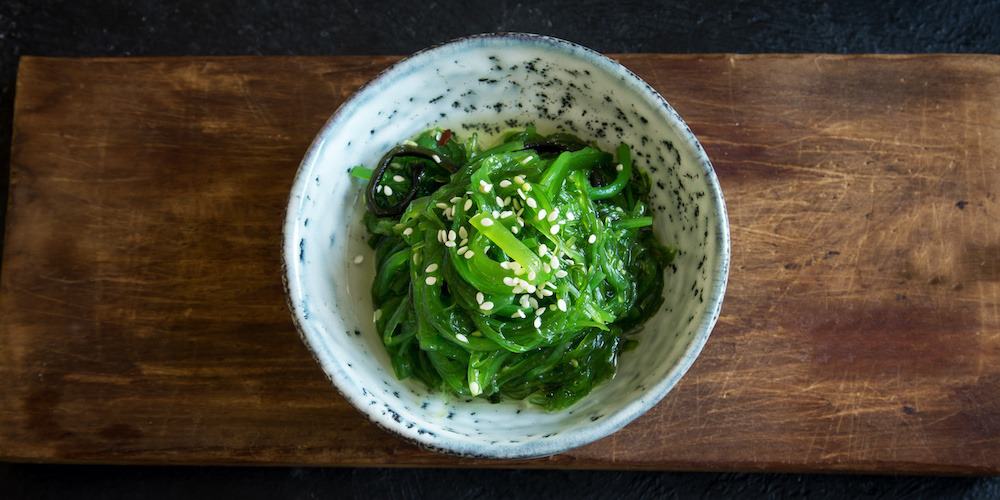BENEFITS OF WAKAME
✓ Very rich in protein
✓ Improves diabetes
✓ Fights obesity
✓ Supports cardiovascular health
✓ Potentially anti-cancer
What is wakame?
Wakame, with the scientific name Undaria pinnatifida, belongs to the Alariaceae family which includes many brown algae. Native to Asia, it naturally grows on the temperate coasts of Japan, China, and Korea. It was later introduced to other parts of the world (Australia, United States, and Europe) where it quickly acclimated.
This seaweed has a lanceolate shape and can measure up to 3 meters in length. Brown-yellowish in color, it is translucent with cut and serrated edges. It is equipped with attachment crampons, called hapteres, that allow it to cling to rocks and a multitude of hard surfaces.
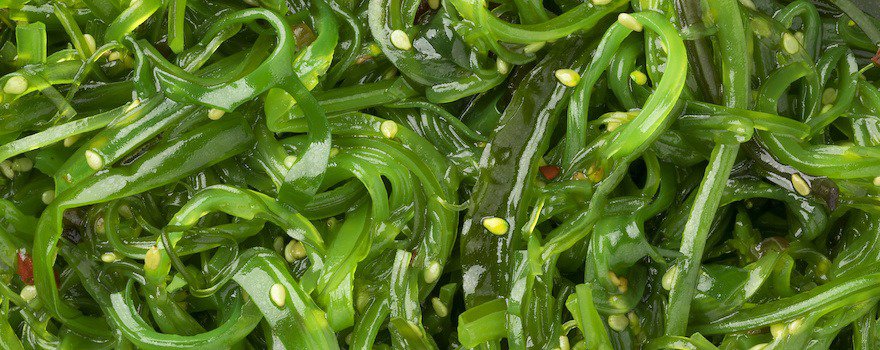
Wakame generally grows between 6 and 12 meters deep. Like spirulina, klamath, or chlorella, it performs photosynthesis thanks to the chlorophyll and pigments it contains. It captures sunlight and transforms it into organic matter for nourishment.
Also called “sea lettuce,” wakame is a typical element of Japanese cuisine. It is commonly used in the preparation of soups, including the famous miso soup, salads, sushi dishes, or tofu. It is also eaten cooked like spinach leaves.
Wakame is appreciated for its marine and iodized flavor, similar to that of oysters. Besides its culinary and taste interest, the seaweed is packed with nutrients.
It is distinguished above all by its high content of plant proteins: 14 g per 100 g. It also contains a wide range of vitamins, fibers, amino acids, fatty acids, and various minerals and trace elements. This exceptional composition endows it with numerous health benefits.
Wakame is also a key food in traditional Chinese and Ayurvedic medicine. Various studies dedicated to the seaweed have highlighted its properties and helped better understand its action on the body. Wakame is first an interesting alternative to animal proteins. It is also recognized for its beneficial effects against diabetes and obesity.
Nutritional Composition
- Amino acids
- Vitamins: provitamin A, B1, B2, B3, B5, B6, B9, C, E, K
- Minerals and trace elements: sodium, calcium, iron, iodine, magnesium, potassium, manganese, copper, phosphorus, zinc
- Proteins
- Lipids
- Carbohydrates
- Fibers
- Polysaccharides: alginate, fucoidan
- Antioxidant pigments: chlorophyll, fucoxanthin
- Fatty acids: omega 3
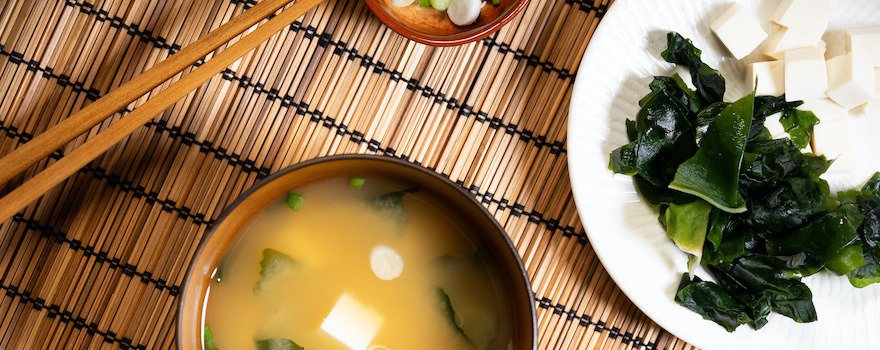
The benefits of wakame
🌿 Very rich in protein
With 14 g of plant proteins per 100 g, wakame is ideal as a substitute for animal-origin proteins. Its protein content is similar to quinoa but surpasses that of goji berries (12 g per 100 g), beans (9 g per 100 g), and cereals in general (8 g per 100 g).
Wakame thus allows for an ample intake of proteins and helps prevent any potential protein deficiency, especially within a vegetarian diet. Remember that proteins are macronutrients essential for energy production and involved in many body functions: cell construction and renewal, hormone regulation, immune defense production, muscle contraction…
Moreover, the proteins of this seaweed have good digestibility. The digestive system is able to absorb and break down a large portion (about 70%) of the proteins into amino acids. These proteins also offer interesting bioavailability: 62% of the available energy is absorbed by the body.
This study from Tokushima University (Japan), conducted on adult men, examined the digestibility of wakame proteins.
🍭 Improves diabetes
Wakame joins the list of superfoods that help fight against diabetes. It regulates blood sugar levels and improves insulin sensitivity.
On one hand, wakame reduces glucose levels in the blood, particularly postprandial blood sugar (blood sugar level after a meal). Its effectiveness seems to be due to fucoidan, a polysaccharide found in brown algae, which stabilizes blood sugar levels. It acts on carbohydrate and fat metabolism by reducing the activity of glycerol-3-phosphate dehydrogenase (GPDH). Finally, fucoidan inhibits lipid storage in adipose tissues.
On the other hand, it reduces insulin resistance in diabetic individuals. This time, it is fucoxanthin, a carotenoid pigment, that is responsible for this action. It regulates the secretion of cytokines in white adipose tissue, which has insulin receptors.
This study from Kyungpook National University (South Korea), conducted on mice, shows how wakame prevents insulin resistance.
This other study from CHA University (South Korea), conducted on mice, explains the beneficial effect of fucoidan on blood sugar.
Finally, this study from the State Institute of Gerontology (Ukraine), conducted on rodents, shows how fucoxanthin affects lipid metabolism.
🏃🏻♂️ Fighting Obesity
Wakame can be of great help in diet and weight loss. Indeed, it exercises an anti-obesity activity by promoting fat burning in adipose cells and acting as a natural appetite suppressant.
The fucoxanthin contained in wakame helps reduce body weight and limit fat accumulation in white adipose tissue. It also promotes fat burning and fatty acid oxidation (or beta-oxidation) necessary for lipid breakdown. This action explains why wakame is effective against hepatic steatosis, a disease characterized by fat accumulation in liver cells and often associated with obesity.
It is also an excellent appetite suppressant. It contains a large amount of fiber (41 g per 100 g) which increases the feeling of fullness and slows the absorption of nutrients. At the same time, they enrich the gut microbiota and improve transit.
This study from Hirosaki University (Japan), conducted on mice, shows how wakame’s fucoxanthin helps with weight loss.
This review from G. D’Annunzio University (Italy) shows the anti-obesity activity of fucoxanthin.
❤️ Supports Cardiovascular Health
Wakame contributes to cardiovascular health and prevents many heart diseases. It significantly reduces blood pressure.
Numerous studies show that it is effective against hypertension. It notably inhibits the activity of angiotensin I-converting enzyme (ACE), which is responsible for vasoconstriction and thus increases blood pressure.
Furthermore, wakame contains an interesting amount of vitamin K (5.3 mg per 100 g) which supports cardiac muscle structure and ensures proper blood clotting. It also contains heart-healthy minerals and trace elements like calcium, magnesium, and potassium, which helps prevent arrhythmias. Not to mention its omega-3 fatty acids, which reduce the risk of heart attacks and coronary diseases.
This study from the National Fisheries University (Japan), conducted on rats, shows the antihypertensive effects of wakame.
This other study from Tohoku University (Japan), conducted on rats, shows wakame’s effect on the ACE enzyme to reduce blood pressure.
🔬 Potentially Anti-Cancer
Wakame has anti-cancer potential. It has already shown encouraging results in fighting breast, pancreatic, and prostate cancer.
The fucoidan it contains has a cytotoxic action: it has the ability to destroy cancer cells. It seems to stop the growth of diseased cells, slow their proliferation, and induce apoptosis (programmed cell death).
This study from Alexandria University (Egypt), conducted on a line of cancer cells, shows the various actions of wakame.
This other study from the Guangzhou University of Chinese Medicine (China), also conducted on cancer cells, shows the beneficial effect of wakame on proliferation, migration, and apoptosis.

How to consume wakame?
Fresh wakame
It is possible to find fresh wakame in some specialty stores, Asian grocery stores, and organic shops. The seaweed can be enjoyed simply in a salad, seasoned with a drizzle of olive oil and accompanied by cucumber, sesame seeds, and slices of ginger. Fresh seaweed is also used in the preparation of miso soups or finely chopped and incorporated into rice or pasta.
Wakame has an oyster and seafood flavor, with a tender and crunchy texture. Algae are generally preserved in salt or seawater. Before consuming, simply rinse them with clear water. Then store your algae in the refrigerator.
Dehydrated wakame
Dehydrated wakame is offered in the form of leaves or flakes. It is necessary to soak them in water for a few minutes to blanch, rehydrate, and restore them to their original size. It can then triple in volume!
You can then consume the leaves or flakes raw or cooked. However, be careful not to cook them too long (between 20 and 30 minutes) as wakame would lose a significant portion of its properties.
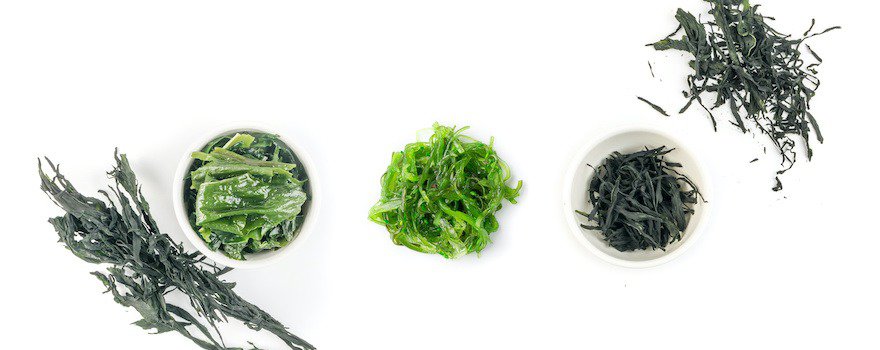
Wakame powder
Wakame powder is obtained from finely ground algae. In this form, wakame makes an excellent salt alternative. A pinch is enough to enhance the flavor of your dishes. You can sprinkle it on salads, rice, soups…
The powder can also be consumed diluted in a glass of water, especially when you want to benefit from its appetite-suppressant effect.
Preferably choose wakame powder that is 100% pure, without additives, preservatives, or GMOs.
Wakame tablets
Wakame is also marketed in tablets and capsules, made from powdered algae. It is an easy-to-find and convenient format to enjoy all the benefits of wakame. It also has the advantage of not conveying its iodized taste, which may not appeal to everyone…
Ideally, favor tablets or capsules sufficiently dosed in wakame (400 mg/capsule minimum), without additives and of plant origin.
Wakame and medicinal plants
To accompany weight loss, wakame can be paired with fat-burning foods, such as green tea or guarana, or with superfoods that suppress appetite like guar gum.
To fight diabetes, wakame pairs well with fenugreek which regulates blood sugar levels.
Consume sustainably: prioritize local, organic, and fair-trade wakame
✓ Japan and Korea are currently the main producers of wakame in the world with 450,000 tons each year. However, since the late 20th century, the seaweed has also been cultivated in Brittany, a region where it enjoys the climatic conditions, strong and cold currents.
✓ Breton producers of wakame have cultivation stations and maritime concessions off the Breton coast such as on Ouessant island. The algae then grow in deep water on stretched ropes. The harvest takes place from April to May, and then the algae is stored in salt.
✓ If possible, prioritize wakame cultivated in France and organic farming. For seaweed from abroad, check that it is cultivated with respect to natural resources. It may also come from a fair trade sector.
Dosage
There is no recommended dosage for wakame. Just be sure not to consume it in excess.
Tablets or capsules should be taken with a large glass of water, 30 minutes before meals.
You can consume it as a 1-month course as part of a slimming diet.
🌿 Fresh: 10 to 20 g per day per person
🌿 Dehydrated: 500 mg per day
🥄 Powdered: 1 teaspoon per day
💊 Tablets: 3 per day for 400 mg capsules
Contraindications and Side Effects
The consumption of wakame presents some contraindications :
- As a precautionary measure, it is not recommended for pregnant and breastfeeding women and young children;
- People suffering from a bleeding disorder or about to undergo surgery should avoid consuming it;
- Due to its effect on blood pressure and high sodium content, it is not recommended for people with high blood pressure;
- Do not consume wakame if you have an iodine allergy;
- Due to its iodine content, wakame is not recommended for people with a thyroid disorder;
The consumption of wakame presents few adverse effects. However, the following side effects may occur:
- Thyroid imbalance
- Stomach pain
- Nausea
- Diarrhea
If you experience side effects, stop consumption and consult a doctor.
History, Culture, and Market of Wakame
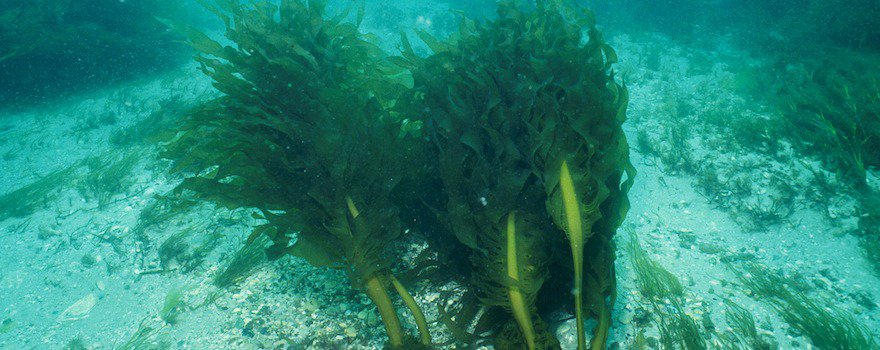
It’s the most consumed seaweed in the world! A very popular food in Japan, wakame has gradually won over European countries. In France, the seaweed was accidentally introduced in the 1970s through young oysters imported from Japan. It first spread to the Thau lagoon and then to the Breton coasts and the Atlantic facade, reaching as far as Spain.
Subsequently, it was introduced in New Zealand, Australia, and the Pacific coast of the American continent. Unfortunately, wakame has become an invasive species in many countries. In France, it is also listed in the INPN’s invasive introduced species list (National Inventory of Natural Heritage).
File prepared by Julia Perez and Charlotte Jean
Sources and Scientific Studies
Y Yamada, T Miyoshi, S Tanada, M Imaki, 1991. Digestibility and energy availability of Wakame (Undaria pinnatifida) seaweed in Japanese.
H J Park, M K Lee, Y B Park, Y C Shin, M S Choi, 2011. Beneficial effects of Undaria pinnatifida ethanol extract on diet-induced-insulin resistance in C57BL/6J mice.
Kui-Jin Kim, Kye-Yoon Yoon, Boo-Yong Lee, 2012. Fucoidan regulate blood glucose homeostasis in C57BL/KSJ m+/+db and C57BL/KSJ db/db mice.
Kh Muradian, A Vaiserman, K-J Min, V E Fraifeld, 2015. Fucoxanthin and lipid metabolism: A minireview.
Hayato Maeda, Masashi Hosokawa, Tokutake Sashima, Katsura Murakami-Funayama, Kazuo Miyashita, 2009. Anti-obesity and anti-diabetic effects of fucoxanthin on diet-induced obesity conditions in a murine model.
Maria Alessandra Gammone, Nicolantonio D’Orazio, 2015. Anti-obesity activity of the marine carotenoid fucoxanthin.
Kunio Suetsuna, Keisei Maekawa, Jiun-Rong Chen, 2004. Antihypertensive effects of Undaria pinnatifida (wakame) peptide on blood pressure in spontaneously hypertensive rats.
Minoru Sato, Takashi Oba, Toshiyasu Yamaguchi, Toshiki Nakano, Takashi Kahara, Katsura Funayama, Akio Kobayashi, Takahisa Nakano, 2002. Antihypertensive effects of hydrolysates of wakame (Undaria pinnatifida) and their angiotensin-I-converting enzyme inhibitory activity.
Samar M Etman, Ossama Y Abdallah, Yosra S R Elnaggar, 2020. Novel fucoidan based bioactive targeted nanoparticles from Undaria Pinnatifida for treatment of pancreatic cancer.
Jun Wu, Hailun Li, Xinyue Wang, Xiaolei Zhang, Weiping Liu, Yumei Wang, Yongbin Zhang, Huafeng Pan, Qi Wang, Yun Han, 2017. Effect of polysaccharide from Undaria pinnatifida on proliferation, migration and apoptosis of breast cancer cell MCF7.


